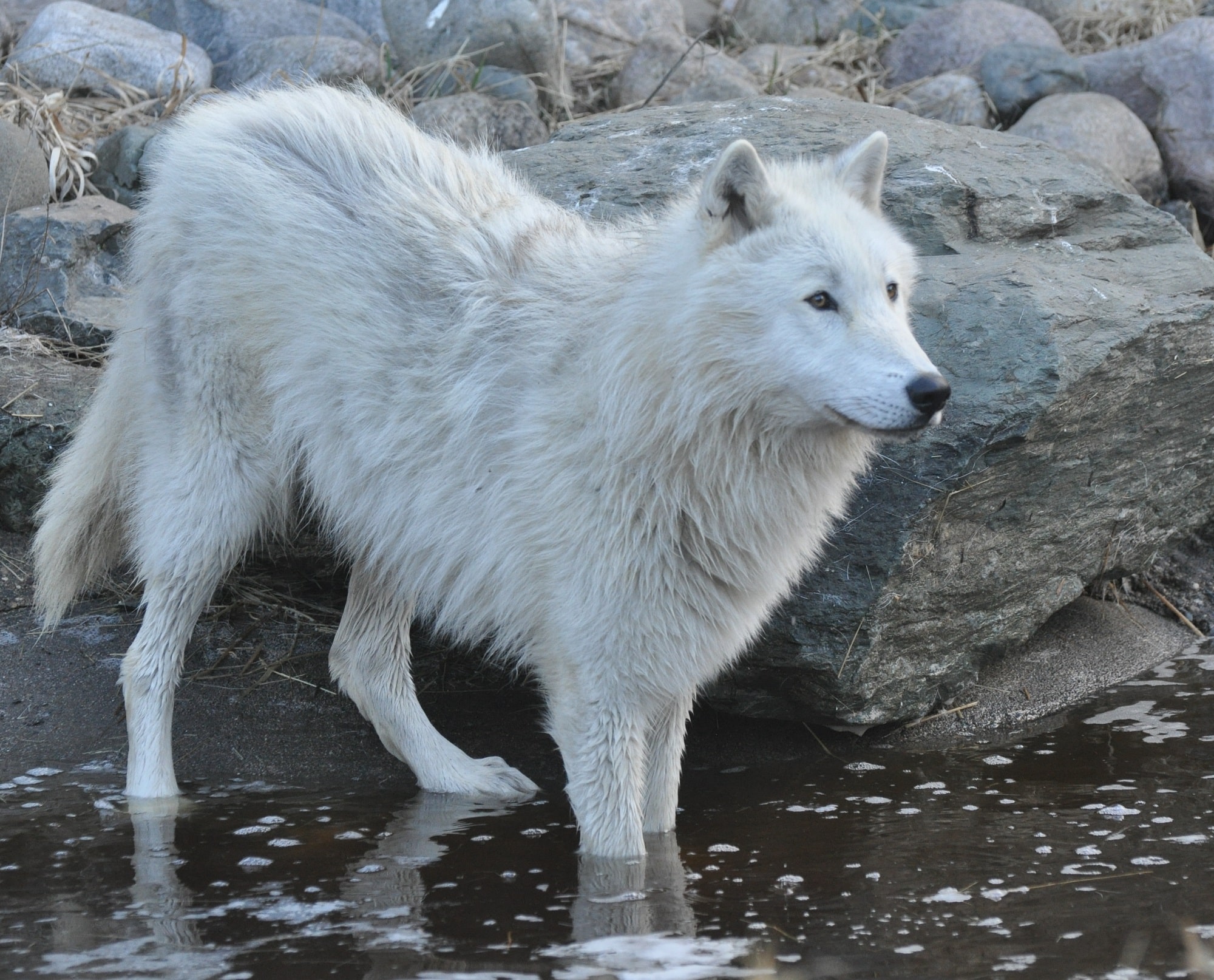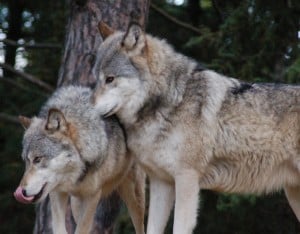Use this quick guide to learn the basics of wolf biology and behavior.
Reproduction
Usually only the dominant pair breeds, however in areas where there is a high ratio of prey per wolf, such as in Yellowstone National Park, there can be multiple litters per pack. In the western Great Lakes area wolves breed in February through March and after a gestation period of 63 days, four to six pups are born in late-April or early-May. However, the higher the latitude, the later the breeding. For instance, wolves in northern Canada living at a latitude of 71 degrees breed in late March through April.

Pup Development

Pup Survival
Pup survival is directly related to prey availability. Prey availability is generally higher in areas that are being newly colonized by wolves, where wolves have been recently reintroduced, or where adult wolves are harvested.

Adult Survival and Longevity
The overall survival of yearling and adult wolves in the western Great Lakes area has been documented to vary between 60% and 80%. Gray wolves are known to live up to 13 years in the wild and 16 years in captivity. However, averages vary based on geographic location.
The University of Wyoming Museum of Vertebrates has created an online database of skulls and skeletons.

Pack and Territory Size
The number of individuals per pack can be highly variable, but averages four to eight during winter in the western Great Lakes area with records of up to 16. Pack size can be as high as 30 or more in parts of Canada and Alaska. A wolf pack will roam and defend a territory of between 25 and 100 miles in the western Great Lakes area. Territories can reach hundreds of square miles where prey densities are in low density such as in northwestern Canada.

Dispersal and Ability to Colonize New Areas
Dispersal is the primary way wolves colonize new areas and maintain genetic diversity. Wolves have been known to disperse up to 550 miles, but more commonly disperse 50 – 100 miles from their natal pack. Generally wolves disperse when 1 – 2 years old as they reach sexual maturity although some adults disperse also. At any one time 5 – 20 percent of the wolf population may be dispersing individuals. Usually a wolf disperses to find an individual of the opposite sex, find a territory, and start a new pack. Some dispersers join packs that are already formed.
 Young Wolves Find Many Ways to Leave Their Parents
Young Wolves Find Many Ways to Leave Their Parents
Spring 2021 issue of International Wolf magazine
Young wolves typically leave home at the age of two or three, striking out to find a mate and form a new pack. The behavior is called dispersal, and according to studies, it appears (crediting Simon and Garfunkel for this terrible pun) there are 50 ways to leave your mother— more or less. Tracy O’Connell describes some of them here, along with factors that may determine dispersal behavior. Learn more.

Habitat Requirements
Wolves can occur wherever there is a sufficient number of large ungulates such as deer, moose, elk, caribou, bison, and musk ox. Wolves were once considered a wilderness animal, however if human-caused mortality is kept below certain levels, wolves can live in most areas. Historically, they once occupied every habitat that had sufficient prey in North America from mid Mexico to the polar ice pack.

Food Requirements
Wolves can survive on 2.5 pounds of food per day, but require about five to seven pounds per day to reproduce successfully. Wolves are estimated to eat 10 pounds of food per day on average. Wolves don’t actually eat every day, however as they live a feast or famine lifestyle. They may go several days without a meal and they gorge on over 20 pounds of meat when a kill is made. Wolves primarily feed on prey animals larger than themselves as this provides food for many individuals. However, wolves will prey upon smaller mammals such as beaver and hare. Because wolves as a species inhabit a much wider area than its prey species, different populations of wolves prey upon different animals. Wolves located in the Western Great Lakes region typically prey upon whitetail deer whereas wolves in central Canada prey primarily on caribou.

Hunting and Feeding Behavior
Click here for in-depth information on wolf hunting and feeding behavior.

Impacts on Prey
Wolf kill rates vary in relation to winter severity. Young, old, and sick prey animals are often nutritionally stressed and have difficulty traveling in deep snow. Wolf kill rates are highest during severe winters and the following spring. Sometimes wolf predation can keep prey populations at low levels for extended periods, but habitat alterations like forest cutting or fire, improved weather conditions, and human management practices allow prey populations to quickly recover.
One example of the predator-prey dynamic is that the reductions in ungulate herds caused by wolves increases habitat quality and helps rid the herd of genetically unfit and diseased individuals. This results in long term maintenance of a healthier ungulate herd. For example, deer and wolves have evolved together and wolf predation has played a crucial role in making the deer what it is today.
You may read more in these two articles that discuss the relationship with wolves and their main prey as well an article written by Glen Delguidice:
Balancing Minnesota’s Wolves, Deer and Moose
Do Wolf Tracks and Few Deer In Your Fall Hunting Area Mean What You Think They Mean?

Population Cycles
Wolf density often changes with the density of their primary prey. For example, in the northern Great Lakes region, the severe winters of 1995-96 and 1996-97 resulted in substantial numbers of deer being stressed and many starved or were killed by wolves. This provided a readily available food supply to wolves and increased their survival.
However, wolf numbers usually decline a year or two following the decline of primary prey. In addition to other factors, the mild winters since 1997 have been favorable to deer populations by increasing the winter survival of deer and in turn increasing the number of fawns being born.

Potential for Population Change
With abundant food and low human-caused mortality, wolves have a high capacity for population growth. In fact, in the right conditions, wolf populations can double in two to three years. From 1997 to 2000 the wolf population in the Northern Rocky states doubled from 200 to 400. Wolf populations can decline, however, if human-caused mortality is consistently greater than 28-50% of the fall wolf population.
Selected References
Carbyn, L.C. 1987. Gray wolf and Red wolf. Pages 361-376 in M. Novak, J.A. Baker, M.E. Obbard, and B Malloch editors. Wild Furbearer Management and Conservation in North America. Ontario Ministry of Natural Resources, Ontario, Canada. 1150 pp.
Fuller, T.K. 1997. Guidelines for gray wolf management in the northern Great Lakes region. International Wolf Center, publication no. IWC97-271. 20pp.
Mech, L.D. 1995. What do we know about wolves and what more do we need to learn? Pages 537-545 in L.N. Carbyn, S.H. Fritts, and D.R. Seip editors. Ecology and conservation of wolves in a changing world. Canadian Circumpolar Institute, occasional publication no. 35. 642 pp.
Nowak, R.M. 1995. Another look at wolf taxonomy. Pages 375-398 in L.N. Carbyn, S.H. Fritts, and D.R. Seip editors. Ecology and conservation of wolves in a changing world. Canadian Circumpolar Institute, occasional publication no. 35. 642 pp.

The International Wolf Center uses science-based education to teach and inspire the world about wolves, their ecology, and the wolf-human relationship.


